Intel's Architecture Day 2018: The Future of Core, Intel GPUs, 10nm, and Hybrid x86
by Dr. Ian Cutress on December 12, 2018 9:00 AM EST- Posted in
- CPUs
- Memory
- Intel
- GPUs
- DRAM
- Architecture
- Microarchitecture
- Xe
Changing How Chips are Made: 3D Packaging with FOVEROS
Anyone who has followed any amount of chip design in semiconductors should well-aware that most of the CPUs and SoCs in production today are based on monolithic dies – single pieces of silicon the have all what is needed inside, before being placed on a package and into a system. While rarer, there are multi-chip packages, were multiple chips go in one package with a shared connection. Beyond this we have seen interposers or embedded bridges designed to bring different chips together with high-speed interconnects. Now Intel is ready to bring 3D stacking into the mass market.
One of the biggest challenges in modern chip design is minimizing die area. A small die decreases costs – typically power too – and can make it easier to implement in a system. When it comes down to extracting performance however, we are at the limits of scale – one of the downsides of big monolithic dies, or even multi-chip packages, is that memory is too far away. Intel today is now ready to talk about its Foveros technology, which involves active interposers in small form factors to bring differentiated technologies together.
Foveros: It’s Greek for Awesome, Apparently
The way Raja introduced this technology started with discussing process technologies. Intel has for many years/decades been focused on high performance process nodes, trying to extract as much as possible from its high-performance cores. Alongside this, Intel also runs an IO optimized process node on a similar cadence but more suitable for PCH or SoC-type functions.
The 126x and 127x are the internal numbering systems for Intel’s process node technologies, although they don’t differentiate between BKM updates for the "+" node variants it turns out. But the point here is that Intel already knows that it needs certain process optimizations in place depending on the type of transistors, performance, and power needed. Going forward, Intel is going to be expanding its node base out so it can cover more power and performance points.
So for this example, Raja pulled out the current set of process technologies for 2019. For a manufacturing process, compute has the 1274 process on 10nm, IO has the 1273 process (14nm), while this new special Foveros technology is under P1222. Alongside the manufacturing, Intel will be working on optimizations focusing on the compute aspects of the manufacturing node. There will also be a set of developments for future node technologies, and the final column shows that Intel has path-finding research to look into future technologies and determine what capabilities will be possible on future designs. This sounds pretty much what a company like Intel should be doing, so no argument from me so far. The goal here is that each type of transistor use case can be different, and there isn’t a one-size fits all approach.
One way to assist with this is through chiplets and packaging. By picking the best transistor for the job in each case, whether it is CPU, GPU, IO, FPGA, RF, or anything else, with the correct packaging, it can be put together to get the best optimizations available.
So here’s where Foveros fits in. Foveros is Intel’s new active interposer technology designed as a step above its own EMIB designs for small form-factor implementations, or those with extreme memory bandwidth requirements. For these designs the power per bit of data transferred is super low, however the packaging technology has to deal with the decreased bump pitch, the increased bump density, and also the chip stacking technology. Intel says that Foveros is ready for prime time, and they can produce it at scale.
So this Foveros ‘3D’ packaging just sounds like a silicon interposer, such as what we’ve seen on AMD’s Fiji or NVIDIA’s high-end datacenter GPUs. However Intel is going above what those products are doing by actually making the interposer part of the design. The interposer contains the through-silicon vias and traces required to bring power and data to the chips on top, but the interposer also carries the PCH or IO of the platform. It is, in effect, a fully working PCH, but with vias to allow chips to be connected on top.
The first iteration of this technology is less complicated that the slide above, just using a set of CPU cores attached to the PCH below, but the idea is that a large interposer can have select functions on it and those can be removed from the chips above to save space. This also lets Intel use the different transistor types in different chips – the example we were given uses an interposer built on the 22FFL process node, with a 10nm set of CPUs on the top die. Above this, DRAM is provided in a POP package. Sounds cool, right?
In actual fact, Intel had a Foveros chip or two working in the demo area. These, Intel explained, were hybrid x86 designs that combined a single big Core with four smaller Atom cores on the same 10nm piece of silicon. I’m sure I’ve heard about big.Little before, but I was shocked that Intel is actually going to do it! We managed to take a photo of the block diagram, which Intel removed from its slide deck before sending it out to the press after the presentations. All details on the next page.


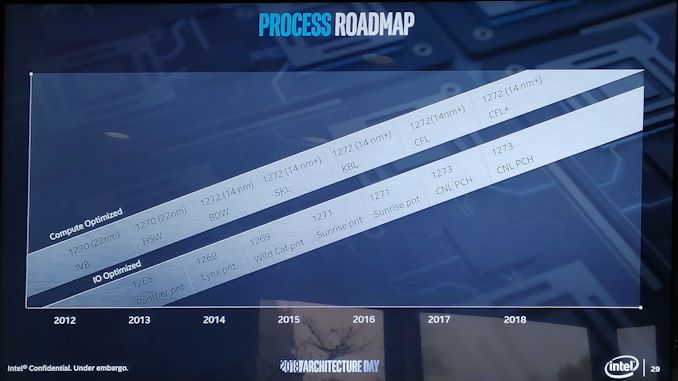
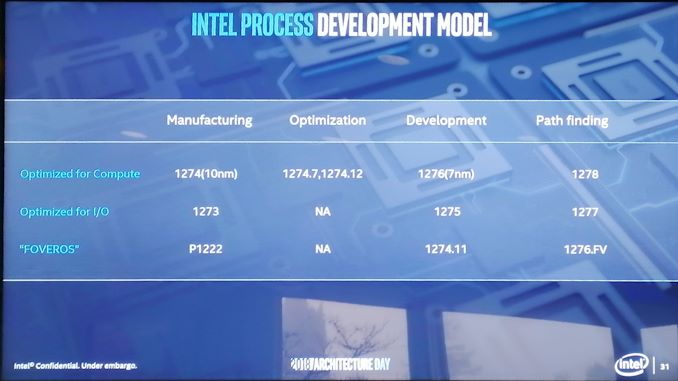
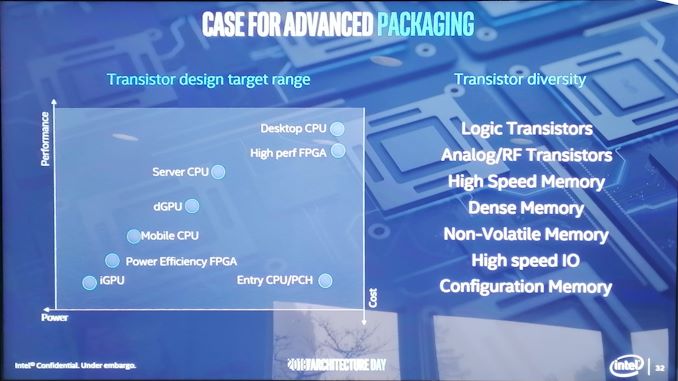
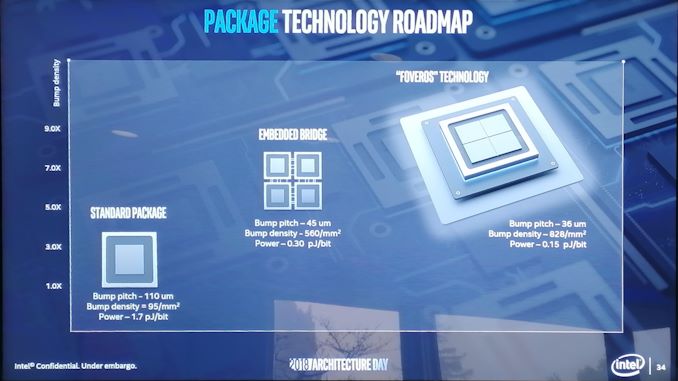
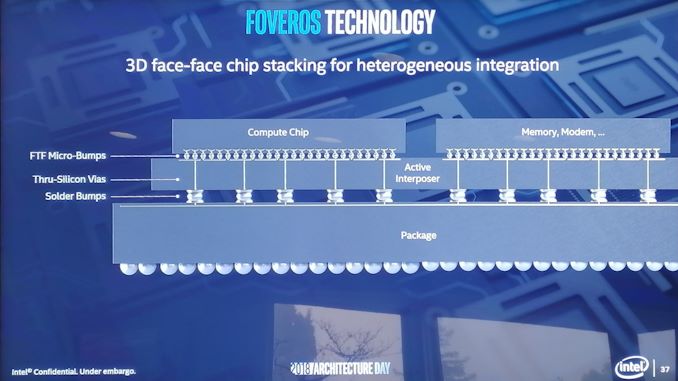
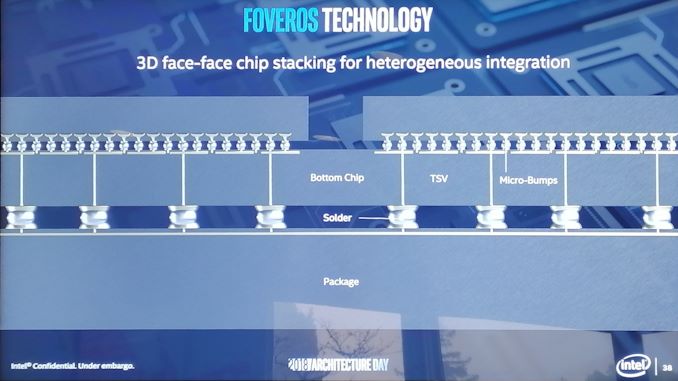








148 Comments
View All Comments
iwod - Thursday, December 13, 2018 - link
Except external GPU.Icehawk - Thursday, December 13, 2018 - link
The number of those sold can be counted on one hand. Ok, maybe two,In all my years I've used a FW cable exactly once.
I've seen a total of two thunderbolt cables, our Mac guy had them for some crap he was doing. IOW, dead just like FW. Proprietary stuff just doesn't tend to last long in an open, commodity, market when equivalents are available for free or pennies on the dollar.
dampf - Wednesday, January 2, 2019 - link
Because nobody knows about it. I'm sure there is a big market for that, just connect a GPU to your laptop via thunderbolt 3 and enjoy high end gaming!johannesburgel - Thursday, December 13, 2018 - link
Nonsense, it's exactly the other way around. Everything is converging on PCI Express. Every peripheral which can actually profit from USB3 speeds would be better off with a direct PCI Express connection instead, and Thunderbolt can do that. USB3 on the other hand requires protocol conversion on both ends of the cable. Instead of being able to just plug a normal GPU, an off-the-shelf NVMe SSD or any other standard device into an external enclosure, without any hardware or driver adaptions, people have to come up with USB3 interface chips and special USB variants of every device.USB3 never had a reason to exist.
HStewart - Thursday, December 13, 2018 - link
I guess you have never truly experience Thunderbolt - it has 40G rate compare USB 3.0 and currently drives a doc - powering multiple monitors plus multiple devices - also remember that it is a superset of USB C Gen 2.Not to mention it has external GPU via PCIe.
HStewart - Thursday, December 13, 2018 - link
TB3 is open up - I believe I saw some foreign TB3 controller out there - but there maybe support issue -Gc - Thursday, December 13, 2018 - link
_eX
looks like it stands for x'ellerator, for many hardware accelerator markets, not just gaming.
Visually, it looks like a tuxedoed figure skater X holding up Microsoft's 'e'.
Samus - Thursday, December 13, 2018 - link
“a customer asked for a product of about this performance but with a 2 mW standby power state. In order to do this, Intel created and enhanced a number of technologies inside the company. The final product is apparently ideal for the customer, however the chip will also be made available for other OEMs.”Clearly Apple.
StrainedDig4 - Thursday, December 13, 2018 - link
Is there a reason when I expand the text screen your video Ads pop up onto the screen, refuse to quit and obscure 1/4 of the display? Are your readers displeasure less important than advertising dollars? I don’t read your articles to buy things, I have Amazon for that, I read to become more informed. Kindly let me know why your pages have become Tomshardware.com lookalikes...ajc9988 - Thursday, December 13, 2018 - link
advertising dollars keep the lights on and pay the salaries of the authors of these articles. Without ads, you don't get to read the content for pleasure, and then it all is a moot point, now isn't it. With that said, could you give constructive criticism on how they could make it less intrusive while still accomplishing the same goal?